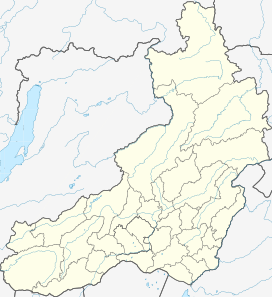| Kontalaksky Golets | |
|---|---|
| Конталакский Голец | |
 Yablonoi Mountains, Tungokochensky District map section showing location of Kontalaksky Golets | |
| Highest point | |
| Elevation | 1,706 m (5,597 ft)[1] |
| Coordinates | 53°54′47″N 115°41′35″E / 53.91306°N 115.69306°E |
| Geography | |
| Parent range | Yablonoi Mountains, South Siberian System |
| Climbing | |
| Easiest route | from Tungokochen, Tungokochensky District |
Kontalaksky Golets (Russian: Конталакский Голец) is a peak in the Yablonoi Mountains. Administratively it is part of Zabaykalsky Krai, Russian Federation.
Geography
[edit]This 1,706 m (5,597 ft) high mountain is the highest point of the Yablonoi Range, a long mountain chain of moderate elevations which is part of the South Siberian System of ranges. It is located in the far northeastern section of the range, just a little north of Tungokochen.[2][3]
The Kontalaksky Golets is a ‘’golets’’-type of mountain with a bald peak. It rises to the west of the valley of the Karenga in a largely remote and uninhabited part of Transbaikalia.[2] There are pillar-like rock formations in this mountain similar to the kigilyakhs of Yakutia.[4]
See also
[edit]References
[edit]- ^ "Zabaykalsky Krai Mountains - PeakVisor". PeakVisor.
- ^ a b Google Earth
- ^ Яблоновый хребет, Small Encyclopedia of Transbaikalia
- ^ W. Dybowski. "Die Gasteropoden-Fauna des Baikal-Sees : anatomisch und systematisch". Volumes 22-28 of Mémoires de l'Académie Impériale des Sciences de St. Pétersbourg. Académie Impériale des sciences. 1875. S2CID 127791013.
External links
[edit]- природа — LiveJournal (Picture of rock formations)

Well, that’s interesting to know that Psilotum nudum are known as whisk ferns. Psilotum nudum is the commoner species of the two. While the P. flaccidum is a rare species and is found in the tropical islands. Both the species are usually epiphytic in habit and grow upon tree ferns. These species may also be terrestrial and grow in humus or in the crevices of the rocks.
View the detailed Guide of Psilotum nudum: Detailed Study Of Psilotum Nudum (Whisk Fern), Classification, Anatomy, Reproduction